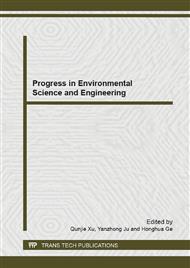[1]
T. Mion,V. Arun, Y. Tsuzuki, T. Matsuo, Effect of phosphorus accumulation on acetate metabolism in the biological phosphorus removal,in: R. Ramadori(Ed.),Biological Phosphorus Removal From Wastewaters (Advances in Water Pollution Control 4), Pergamon Press,Oxford,1987,pp.27-38.
DOI: 10.1016/b978-0-08-035592-4.50009-2
Google Scholar
[2]
V. Arun, T. Mino, T. Matsuo, Biological mechanism of acetate uptake mediated by carbohydrate consumption in excess phosphorus removal systems, Water Res. 22(1988)565-570.
DOI: 10.1016/0043-1354(88)90056-5
Google Scholar
[3]
H. Satoh, T. Mino, T. Matsuo, Uptake of organic substrates and accumulation of polyhydroxyalkanoates linked with glycolysis of intracellular carbohydrates under anaerobic conditions in the biological excess phosphate removal processes, Water Sci. Technol. 26(5-6)(1992)933-942.
DOI: 10.2166/wst.1992.0535
Google Scholar
[4]
G.J.F. Smolders, J. Van der Meij, M.C.M. van Loosdrecht, J.J. Heijnen, Model of the anaerobic metabolism of the biological phosphorus removal process: stoichiometry and ph influence, Biotechnol. Bioeng. 42(1994)461-470.
DOI: 10.1002/bit.260430605
Google Scholar
[5]
G.J.F. Smolders, J. Van der Meij, M.C.M. van Loosdrecht, J.J. Heijnen, Stoichiometric model of the aerobic metabolism of the biological phosphorus removal process, Biotechnol. Bioeng. 44(1994)837-848.
DOI: 10.1002/bit.260440709
Google Scholar
[6]
H. Pereira, P.C. Lemos, M.A.M. Reis, J.P.S.G. Crespo, M.J.T. Carrondo, H. Santos, Model for carbon metabolism in biological phosphorus removal processes based on in vivo 13 C-NMR, Water Res. 30(1996)2128-2138.
DOI: 10.1016/0043-1354(96)00035-8
Google Scholar
[7]
ZHENG Xingcan, LI Yaxin. Phosphorus and nitrogen removal from wastewater technology[M]. Beijing: China Building Industry Press,1998.
Google Scholar
[8]
S.H. Chuang, C.F. Ouyang, H.C. Yuang, et al. Effects of SRT and DO on nutrient removal in a combined AS-biofilm process[J]. Water Science and Technology,1997,36(12):19-27.
DOI: 10.2166/wst.1997.0426
Google Scholar
[9]
LIU Yan, CHEN Yinguang, ZHENG Hong, et al. Effect of different ratios of propionic to acetic acid on phosphorus removal by an enriched culture of phosphorus accumulating organisms[J]. Acta Scientiae Circumstantiae(In Chinese),2006,26(8):1278-1283.
Google Scholar
[10]
Andrew Amis Randall, Yan-Hua Liu. Polyhydroxyalkanoares from potentially a key aspect of aerobic phosphorus uptake in enhanced biological phosphorus removal[J]. Water Research,2002,36(1):3473-3478.
DOI: 10.1016/s0043-1354(02)00047-7
Google Scholar
[11]
Ministry of Environmental Protection of the People's Republic of China, Water and wastewater monitoring analysis method(Fourth Edition)[M]. Beijing: China Environmental Science Press,2002.
Google Scholar
[12]
YVES COMEAU, KENNE TH J. HALL, AND WILLIAM K. Determination of Poly-β-Hydroxybutyrate and Poly-β-Hydroxyvalerate in Activated Sludge by Gas-Liquid Chromatography. OLDHAM APPLIED AND ENVIRONMENTAL MICROBIOLOGY, Sept.1988, P.2325-2327vol,54,No.9
DOI: 10.1128/aem.54.9.2325-2327.1988
Google Scholar
[13]
Pijuan M, Saunders A M, Guisasola A, et al. Enhanced biological phosphorus using propionate as the sole carbon source [J] . Biotech Bioeng, 2004, 85(1): 56-67.
DOI: 10.1002/bit.10813
Google Scholar
[14]
Oehmen A, Zeng R J, Yuan Z, et al. Anaerobic metabolism ofpropionate by polyphosphate-accumulating organisms in enhanced biological phosphorus removal systems[J]. Biotech Bioeng, 2005,91(1): 43-53.
DOI: 10.1002/bit.20480
Google Scholar
[15]
Lu H, Oehmen A, Virdis B, et al. Obtaining highly enrichedcultures of Candidatus Accumulibacter phosphates through alternating carbon sources [J]. Water Research, 2006, 40(20): 3838-3848.
DOI: 10.1016/j.watres.2006.09.004
Google Scholar
[16]
ZHANG Chao, CHEN Yinguang, LIU Yan.Effect of different ratios of propionic to acetic acids on long-term cultured active sludge for enhanced biological phosphorus removal[J]. Environmental Science(In Chinese),2008,29(9):2548-2552.
Google Scholar
[17]
Wang N D, Peng J, Hill G. Biological model of glucose induced enhanced biological phosphorus removal under anaerobic condition[J].Water Research,2002, 36(1):49~58.
DOI: 10.1016/s0043-1354(01)00236-6
Google Scholar


